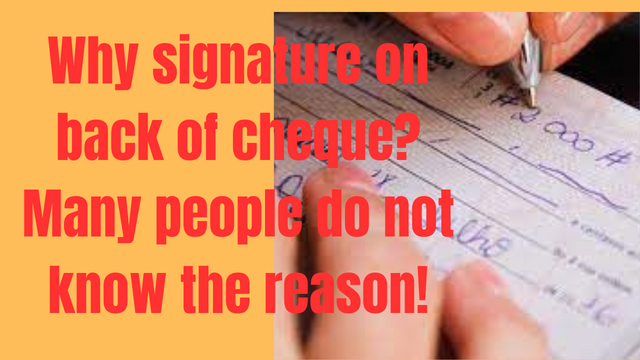Why signature on back of cheque? Many people do not know the reason

In the modern era, a multitude of avenues exist for conducting financial transactions. These include withdrawing funds from one's account using diverse methods such as Automated Teller Machines (ATMs), Net Banking, UPI transactions, or even the conventional medium of cheques. Although certain banks offer a direct withdrawal procedure, many require customers to physically visit the bank premises for collection, often through the issuance of challans or cheques.
Interestingly, when using cheques for transactions, it is common for cashiers to request signatures on both the front and back of the cheque. The rationale behind this dual signature requirement on cheques is often a mystery to a significant number of individuals. This prompts the question: why is the back of the cheque signed when the front, which bears the issuer's signature, already exists?
Conversely, it's important to note that not all cheques require signatures on their reverse side. This distinction regarding the necessity of back-end signatures remains relatively obscure. In the following discussion, we will delve into the specifics of this matter, shedding light on which cheques require signatures on the reverse side and the consequences of failing to provide such a signature.
First and foremost, it is pertinent to clarify that the practice of signing the back of the cheque pertains to what is known as a Bearer Cheque. Essentially, this type of cheque can be presented to a bank by anyone and subsequently redeemed for cash. Unlike other forms of cheques, where payment is exclusively made to the individual whose name is inscribed, a bearer cheque introduces an element of universality in terms of the recipient. The person whose name appears on a bearer cheque need not be the individual who ultimately redeems it for cash.
In contrast, the Order Cheque operates under a distinct principle. This type of cheque mandates that payment is disbursed exclusively to the individual specified by name on the cheque. Moreover, for the payment to be processed, the designated individual must be physically present at the bank. As such, an additional signature on the back of an Order Cheque is not obligatory. Prior to releasing funds against an Order Cheque, bank personnel rigorously scrutinize the authenticity of the presenter's identity to ensure that the right person receives the funds.
However, a noteworthy scenario arises when a bearer cheque is lost, stolen, or misplaced. In such circumstances, there is a higher likelihood that the individual who comes into possession of the cheque might attempt to cash it. This potentially raises concerns and questions for the bank, especially if the original bearer is not the one redeeming it. To mitigate such risks, one approach is to encourage the individual redeeming the bearer cheque to sign on its reverse side. This act signifies their acknowledgment of assuming responsibility for the funds and absolves the bank of liability in the event of an erroneous transaction.
In cases where the amount on the cheque exceeds 50,000 rupees, banks often exercise prudence by requesting additional documentation such as proof of address from the individual seeking to withdraw the funds. This step ensures a higher level of verification before releasing the funds. Furthermore, the signature present on the front side of the cheque holds equal significance to the one on its reverse. If an individual is reluctant to provide a signature, they have the option to attach a formal application requesting to personally receive the funds.
To recapitulate, the act of signing the back of an Order Cheque is not a requirement. Additionally, when withdrawing funds from one's own account via cheque, a signature on the back of a bearer cheque is not obligatory. The necessity for a reverse-side signature only arises when a third party, at the behest of someone else, seeks to withdraw funds using a bearer cheque.
In conclusion, the nuances of cheque signatures reveal a dual nature in the world of financial transactions. The Bearer Cheque stands as a symbol of financial flexibility, where anyone in possession can claim the funds. Contrastingly, the Order Cheque prioritizes security, ensuring that only the designated individual can access the funds. By understanding the intricacies of these signature requirements, individuals can navigate the realm of financial transactions with greater awareness and comprehension.